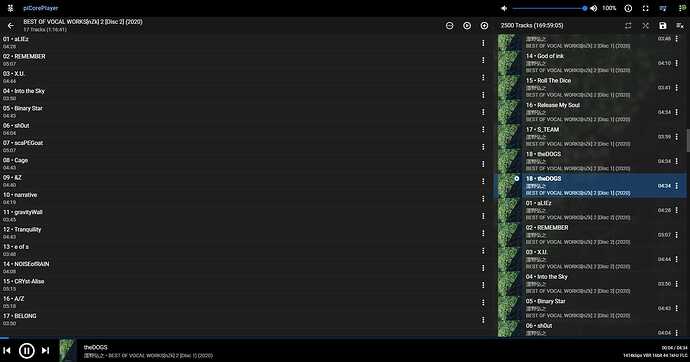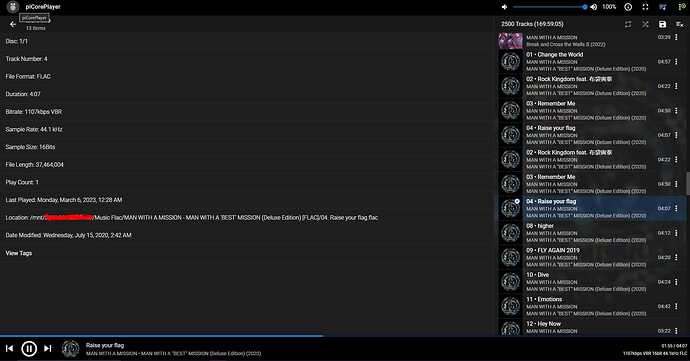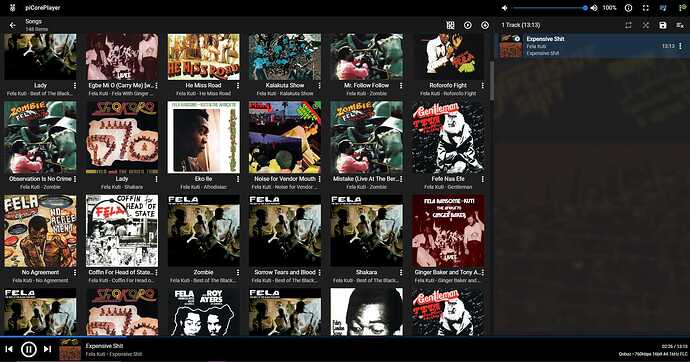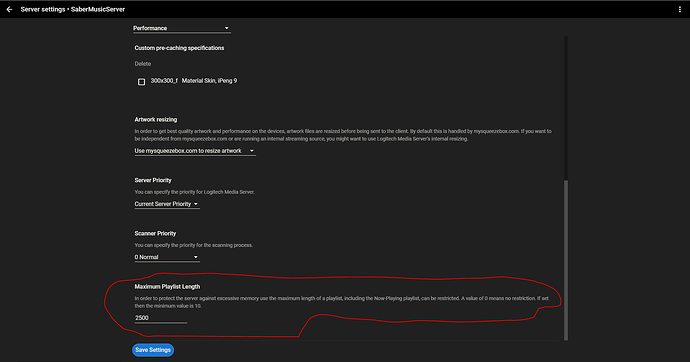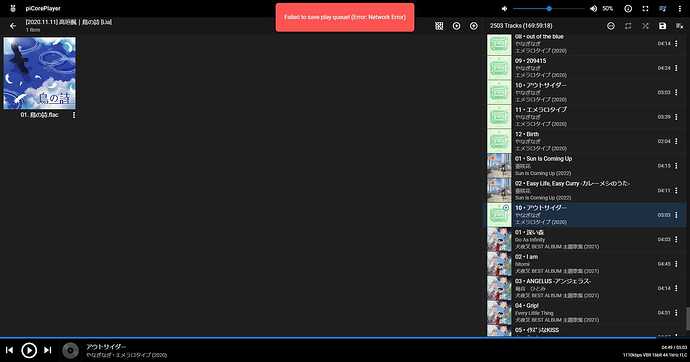Yes, it basically comes down to this I guess. You can optimize your own situation but it’s difficult to generalise any conclusions. It’s all very depending on various factors and even personal taste comes into play.
They changed the requirements for qualification, there is a base testing charge and a royalty charge to the manufacturer as well as the end user. And I believe just using the bridge is not considered a good enough solution anymore, which means the cost of supporting it has risen.
Interestingly Vincent flashed my TotalDAC Streamer with firmware that only supports Roon, because supporting multiple formats impacted quality. The multiformat image is available.
I was thinking about the same for the opticalRendu but in their case if it’s not enabled it shouldn’t be causing any overhead.
For now I returned to Roon until I feel familiar enough with the Antipodes sound before I can realistically compare it to LMS.
Those antipodes comments already create bias which isn’t great but if they feel it really is the best possible solution on their devices I probably should give it a fair shot and see where it takes me. UX is important to me but sound quality is more important. That said, if it’s minimal differences but the UX is much worse I might still keep Roon. I don’t use many of its features tbh
To be continued!
Definitely looking forward to hearing your feedback and what you end up with
Ok, so I have gotten my Pi2AES (RPi4) for about a week and installed PiCorePlayer using LMS/Squeezlite. Been playing with it on and off until this weekend. I do like how it sounds so far but honestly didn’t do a serious A/B comparison besides turning off LMS to make the Pi2AES stream Roon for a little while. I think the PiCorePlayer LMS GUI is pretty good. The only annoying part is that the playlist will say 2500 if you go above 2500, but it’s actually more. Then, when you try to go click a song in the playlist that’s over 2500 songs, it goes to the 2nd or 3rd song above it instead of the song I actually click which is kinda annoying. Then it will look like a duplicate in the playlist which might trigger some people’s OCD. Besides that, it’s got some cool features like band biography, artist recommendations, and lyrics like in Roon. Qobuz looks ok as well. Once you found your artist or album, it doesn’t look that bad.
The playlist issue gets fixed using the iPeng app on IOS but it still will show a graphical glitch saying 2500 songs which I guess is not really that bad. Overall, I do miss Roon UI, but I think I could try to get used to LMS UI. I’ll play with it more this week and maybe do a sound comparison with LMS/Squeezelite vs Roon/Squeezelite. Probably not going to post the comparison here since I’m pretty bad at describing sounds, but I hope I like LMS/Squeezelite and not miss Roon UI ![]()
Minor Issues:
Cool LMS/Squeezelite features:
Qobuz:
Edit in Post Discovery
It looks like you can surpass 2500 songs in a playlist, but the player might get a little bit more unstable. The more I spend time with the LMS/Squeezelite, the more I am liking it. Hopefully I can adjust the settings to more my liking while keeping the player stable. I also look in the LMS forum and there is a window version of squeezelite called Squeezelite X. I might give that a try to see if its more stable over there or I can just use IPeng on my iPhone to control the server since IPeng seems more stable than the web browser.
Another Update
I can’t get the playlist to save over 2500 songs LOL. I set the “Maximum Playlist Length” to 0 (unrestricted) and the new playlist just won’t save. I guess I can just give up on that… I’m setting the max back to 2500 songs max for the playlist since it seems more stable that way. I think I might explore tagging, that might be an easier solution ![]()
Expanding the Playlist Song Capacity:
So I think I finally hit a total synergy goal/home-run in my main 2 channel system. It kinda happened a bit by chance and constant upgrades but it’s absolutely a sound quality/character win for me ![]()
Let me preclude all by saying I very much value my soundstage, imaging and “sound space” more than other qualities and characteristics in my own systems. Everything beyond the qualities I value falls under “sound flavors” for me.
I very much enjoy and value all that ROON offers but ever since I did a head to head comparison vs the Innuos Sense streaming software I knew that Sense was ultimately my preference based on the sound characteristics it provided. I did not understand fully why or how, but streaming through Sense simply sounded better to me based on my preferences.
I know it’s a combination of speaker and seat placement, front end upgrades, DAC & amplifier pairing and finally a switch in my source software that has led me to this final conclusion and change but I will be swapping over fully to Innuos Sense software for my streaming pleasure and the difference is this; ROON sounds great. I have excellent depth, height, stage, No complaints. The Innuos sense software does me one better, it puts me in a small venue sitting in front of the stage where the performance is taking place. That’s as good a description of the differences I can offer. It’s a vivid difference, it’s very worthwhile to me. It may not be to everyone’s preference, but to me it was worth every dollar and slow experimentation over the years.
I really did not know a system could sound this palpable, realistic and spacious. The system is honestly presenting and sounding better than anything to date.
ROON is good, but currently in my opinion and personal experience, even the software used to stream can make a difference in the sound characteristics that may add or detract from your system performance.
Good luck in your own choices, I will continue to try head to head comparisons to make sure it’s not something else giving me the changes but I’m pretty sure it’s the software that was one of the last tweaks I needed for myself.
How would you descri Roon in comparison to this?
Thanks for sharing!
Innuous seems like they do a lot to get their sound through their SW. It’s no coincidence they’re open about not paying in the Roon space. In my experience with dCS it was clear they didn’t anything special with their SW, Lumin didn’t either in my experience with their ecosystem. I’m wondering more and more about something proprietary that’s being bypassed with Roon and not through your Innuous player.
I never asked but how did all of your optical implementations work out and is the Innuous revelation more noticeable upstairs in your small system than downstairs in your big system?
Not accustomed to you posting messages before me in the AM. lol
It’s different, and very different and more different now that I also installed the Innuos Ethernet switch than the first time I did the comparison.
The ROON sounds real good, the stage is BEHIND the speakers along with good width and height. With the Innuos streaming software the soundstage is completely different, you are sitting AMONGST the performers. It’s much more spacious and sounds are around you, rather than forward past/behind the speakers. It’s more immersive and I don’t want to make this comparison but it’s more akin to a multi speaker HT system where you have incredible dimension.
Am I giving a better description, it’s sooo very hard to describe until you HEAR and experience it yourself ![]() it’s hands down, to me, so much more realistic and immersive than ever before and it’s only 2 channels
it’s hands down, to me, so much more realistic and immersive than ever before and it’s only 2 channels ![]() I’m so very sure though it’s a combination of tweaks that have all finally fallen in line with each other and not one single piece of equipment. What seems to have put it over the edge though was the change in software used to stream. That’s why I posted here.
I’m so very sure though it’s a combination of tweaks that have all finally fallen in line with each other and not one single piece of equipment. What seems to have put it over the edge though was the change in software used to stream. That’s why I posted here.
I’m posting well away from home, thus the early early post. I’m talking about the main system in the big music room. This is the one that blew my mind before I took off for Greece.
Upstairs in the smaller room with the upgrade to the SOTM, Sonnet DAC and fiber optics, the HP system sounds most clearly detailed, vibrant and exciting. More so than ever before.
I’m still playing with the 2 channel, and it sounds great but it can’t touch the main system in its incredibly immersive sound characteristics.
This is the big elephant in the room with streamers generally, no one knows what the software does to the original signal.
If you believe the investigation on the Roon forums, Auralic for example process everything that goes through their boxes, and I defy you to find where they tell you that, they even use the term bit-perfect on their website. But there was an issue with Roon (apparently now fixed) where they were bypassing that processing.
I have tried to be very careful in posting my own experiences, I don’t want to mislead anyone or say something that may not be true. I also don’t want to be the fool that speaks out of his ass.
I will do some more head to head comparisons in the next few weeks but currently based on my own personal experiences my belief is that there are sound character differences that can be perceived audibly via the differing software presentations. This overall presentation in my situation has been substantial enough to make a post worthwhile and to continue to experiment.
This hobby truly is a journey of discovery experiences and learning.
So true. Very well said. Cool people, too! ![]()
it’s like “security through obscurity” → “fidelity through obscurity” ![]()
We need a HiFi network streaming open-source project…
well… here I go… ![]()
I wonder if part of the differences we seeing / hearing are based on the type of Roon endpoint being used: integrated all-in-one streamer (with either SPDIF type digital outputs or with integrated DAC analog outputs) vs a simple Roon endpoint with a USB output. With the USB output, I would think my end sound quality is much more dictated by the USB implementation of my DAC or the DDC between the streamer and the DAC. For the all-in-one type products, there’s a lot happening between the RAAT data stream coming in, and music coming out, that the vendor is controlling. If they are optimizing the signal processing on a data path with their own streaming implementation, and not focusing on optimizing the Roon path, then i could see it sounding different. Or maybe RAAT is proprietary enough that they can’t get into it far enough to fully optimize the signal processing the way the want…
I do think the evidence adds up that Roon is simply streaming uncompressed FLAC files. They claim it on the Roon forums, and in watching network traffic between my Roon core and the endpoint, I see the bitrate match the audio file bitrate. But what happens at the endpoint after streaming is a different question. On the Roon forums they talk about some amount of code execution, that enables them to modify (“upgrade”) endpoint behavior via RAAT. I’m sure there’s actually quite a bit of activity in the endpoint to make sure the playback is as glitch free as possible and enables their various network control features.
Once upon a time, network streaming was a unique feature for Roon in the HiFi market. Now it’s really not that differentiating (they do it well, but I can do multi-room streaming other ways). If they would now opensource RAAT (or at least a portion of it) and enable others to develop on it and use it, I would think it would be a boost to Roon adoption / integration. Set some compatibilities rules in the open-source licensing agreement. Maybe it would give Roon some free R&D? Simplistically, I think of it similar to how Chromium is open-source, and Google has their own version that they release (Chrome). But such an arrangement would require a MUCH better quality control system, with robust pre-release verification… which Roon definitly does NOT have ![]()
Do you think the differences would be less apparent with headphones?
There really is nothing to this, UNLESS it’s a UDP connection (which I doubt).
Or it’s encrypted (maybe).
The network Hardware literally just provides the OS with a piece of memory with 1 MTU in it.
Depending on the network stack it MIGHT copy it before you get a pointer to it. But that would be the same for any implementation.
The client application likely will copy it into a buffer, but once you have uncompressed bytes, you literally either just shove bytes into a FIFO, or more likely setup a DMA operation that does that for you in hardware.
Most of this just isn’t a software problem.
Both the Ethernet controller and the USB device (if you outputting via USB) will have their own CPU’s, it was a bit of a joke when people connected Arduino’s to ethernet that the ethernet adapter would have a more powerful processor than the actual Arduino in it.
Then they would actually have less work todo than any other format. For both DLNA and Squeeze the server just hosts the file and the streamer has to decode/decompress it, not that it’s a lot of work to do that now.
In fact almost all of them use the same software to do it, and it’s in fact why we end up with streamers running cut down linux variants rather than some custom RTOS.
Short of there is something broken in RAAT or the implementation there of, I really don’t have any even vaguely reasonable explanation as to why RAAT should sound in any way different than other protocols, short of one or the other messing with the bits in someway.
I can’t tell the difference on the NS1 between DLNA and Roon via RAAT, but lots of people report differences on other streamers.
Again I never try and tell people what they hear, there is clearly some perceived difference, but I’m at a loss as to why if the bits aren’t changed in the streamer there is a difference. Short of handwavy, more CPU = more Noise, and perhaps one path has burstier CPU usage than another, or prevents the CPU running in some low power mode for some reason.
It’s on my listen and decide for yourself, and don’t worry about why list.
my listening comparisons so far between Squeeze and Roon did not lead me to think there’s a difference and if so I’m not even sure which I prefer it’s so small. But I’m not at a point to conclude the experiment yet.
Too much work to test it with my opticalRendu but like you no difference for me with the dCS. I will make it a point to listen for it in @NickMimi system at some point.
I’m actually in the same boat as you lol. That’s why I didn’t really comment on anything sound quality-wise comparing Squeeze and Roon. I tried using my Polk Reserve R200 speakers since that’s usually my go-to for getting sound difference on my setup. When I upgraded to the Mojo Mystique Evo DAC and use my speakers 1st as a test if it works, I immediately knew the difference. With Roon comparing with Squeeze, I thought I knew, but when I went back to the other, I question myself if it really sound different. I’ve been only testing the streamer portion of it and only did the test like twice within 2-3 weeks. I am also using a Pi2AES, so my equipment probably isn’t high enough in the tier to hear the difference.
In the end, though, I got tired of swapping SD cards, so just stick with to stick with LMS/Squeeze just because it’s more convenient for me since I can access the player on any electronic device without an app. All I really do is go on a browser and do LAN IP:9000 and boom, any electronic device is my remote.
